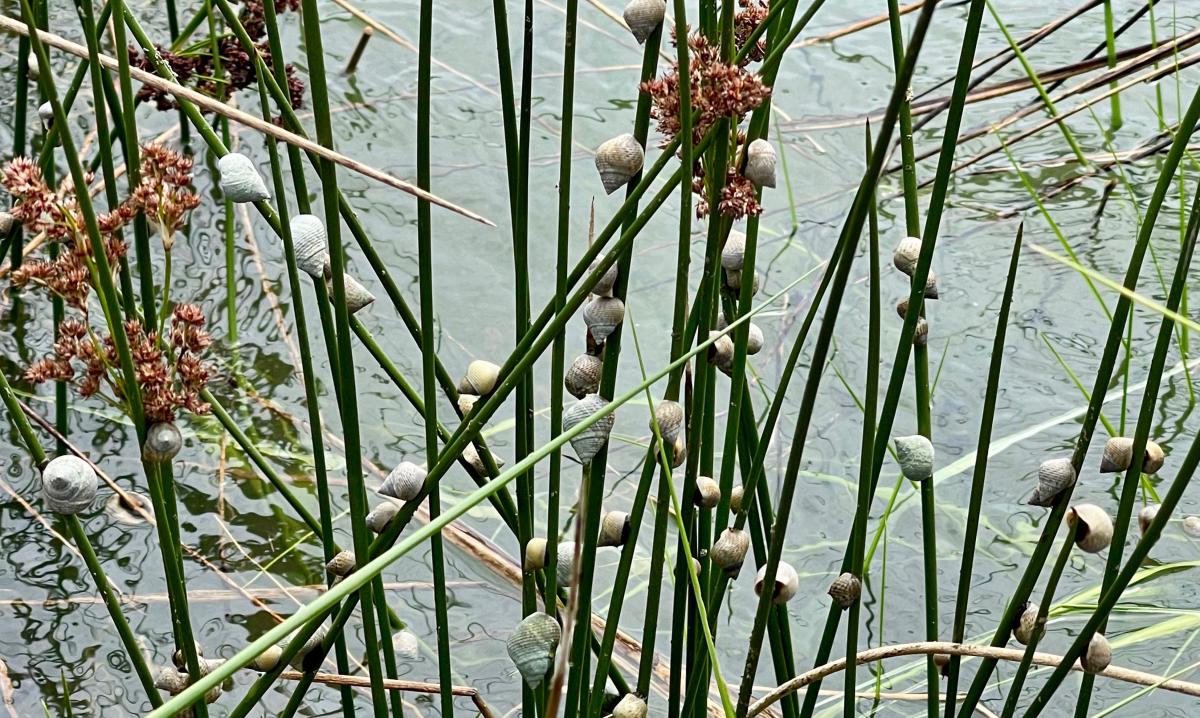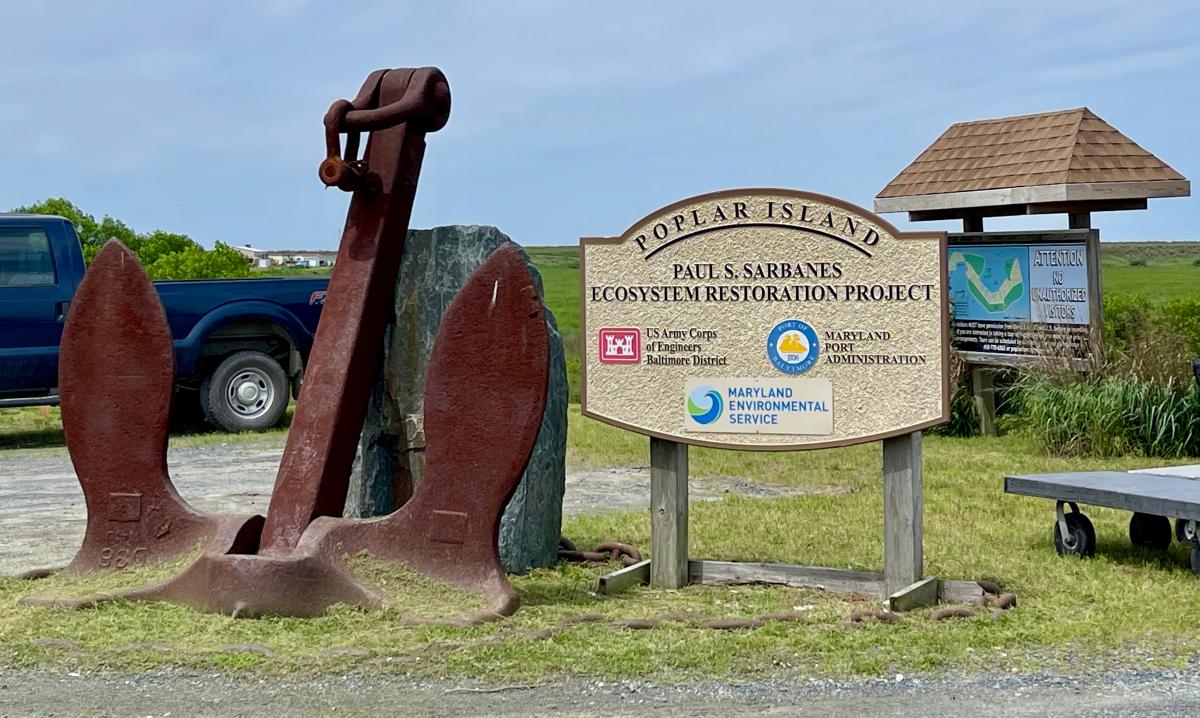
Kristina Motley, senior environmental specialist for Maryland Environmental Service, discusses the estimated 15-year-old diamondback terrapin that she picked up out of the way of the Poplar Island tour bus. Motley said females are about twice the size of male diamondback terrapins. The white lips of these terrapins are an identifying characteristic.
Rain falling on the eastern slopes of the Appalachians in the Shenandoah region eventually make their way into the Chesapeake. But whether there’s more than just a philosophical and linguistic connection between the pennywinkers that feed trout in the rain-fed rocky rivers falling out of Virginia’s Appalachians, and the periwinkles that feed diamondback terrapins in the Chesapeake’s marshes, is a matter better left for real scientists.
Pennywinkers first came to my attention a few decades back during a hiking trip into St. Mary’s Wilderness near Waynesboro, Virginia. We crossed paths with fishermen working the downward flowing waters of St. Mary’s River, not much wider than a strong leap and barely more than ankle deep.
One of the trio of anglers, already tired of fishing, sat on a riverside log among our group. Soon the swapping of stories and conversation competed with the babbling of the river.
At one point he stopped between stories and made a comment in his slow mountain accent that has stuck:
“Fishing’s fun,” he said, “but I’d rather talk – wouldn’t you?”
We laughed and he didn’t wait for any other response before he launched into a short dissertation on the supremacy of pennywinkers as trout bait.
We knelt beside him and watched closely as he stuck his hand in the silty mud at the edge of the river. He picked up a few clumps of small sticks, only a few inches in length and not much more than a sixteenth of an inch in diameter.
I tell you this in such detail because if you ever find yourself in a survival situation in the mountains and have to catch a trout, finding a pennywinker to bait a small hook will be absolutely essential, though not necessarily legal. When you’re fighting for survival, any port in a storm. Otherwise the St. Mary’s River is artificial lures-only for trout fishing.

Periwinkle snails, a favorite food of diamondback terrapins, climb their way up marsh grass stalks to stay out of the reach of rising tides.
Our fishing/talking friend sorted out two of the little sticks joined together lengthwise by what appeared to be a third short stick between them.
Eureka.
That short stick between the two others was the unpretentious home of a pennywinker, though I’m pretty sure that’s not the creature’s Latin name. He pulled the sticks apart, carefully opened the third joining stick and there was a wriggling little wormy-like thing that fit conveniently and irresistibly on a small, trout hook.
He picked up his rod, deftly hooked the pennywinker, eyeballed the river for a likely pool – while keeping up the conversation of course – dropped the lightly weighted rig into the water and within a minute or two a seven-inch or so brown trout proved his point.
He bid us adieu, leaving us with our newfound knowledge, picking his way carefully along the slippery, rocky path beside the river, quickening his pace to rejoin his compatriots who had long before disappeared further upstream seeking more productive and quieter fishing.
Fast forward to last week during a tour of the $1.5 billion Poplar Island restoration project. This is where we switch gears from pennywinkers to perrywinkles.

The Poplar Island restoration project has been underway since the early 2000s and is expected to continue to take dredged materials from shipping channels until almost 2040.
The US Army Corps of Engineers project at Poplar Island, in Chesapeake Bay just west and north of Tilghman Island, aims to benefit the region’s economy and environment. It re-uses silt and sediment dredged out of the approach channels traveled by ships heading for and leaving the port of Baltimore. Recreating the once-inhabited island, nearly 2,000 acres in the mid- to late-1800s but abandoned and radically eroded to a little more than five acres by the 1970s, provides a resting place for the dredged spoils. That keeps the approach channels open for shipping.
At the same time, the project is also recreating a valuable remote Chesapeake wildlife habitat and preserve.
Since the first dredged spoils were placed in 2001, the new, armor stone-perimetered island has regrown to 1,715 acres of upland and marsh habitat, home to hundreds and hundreds of plant and animal creatures. At least 250 species of birds have been documented on the new Poplar as a resting and nesting place, including song birds, wading shore birds, waterfowl and birds of prey.

The Poplar Island restoration project has been underway since the early 2000s and is expected to continue to take dredged materials from shipping channels until almost 2040. Army Corps scientists thought they would have to fertilize the dredged materials to foster growth but were pleasantly surprised that the fertility of the spoils was rich enough without supplements. One scientist said the dredge spoils are composed primarily of silt and sediment entering the Chesapeake via the Susquehanna River at the north end of the bay. That silt and sediment, he said, likely comes from New York and Pennsylvania farmland washed into the river by rain-driven runoff.
Its marshes, upland areas and brackish waterways have also become home to thousands of diamondback terrapins, Maryland’s once-endangered state reptile. How do diamondback terrapins fit into the Army Corps’ beneficial environmental use scheme?
It turns out the diamondbacks are molluskavores, meaning they eat shellfish. Their strong jaws and beaks make short work of the hard shells that protect the succulent creatures inside including clams, mussels, oysters and periwinkles.
Periwinkles are pretty little brownish-shelled snails. Unlike pennywinkers that attach themselves to sticks in mountain streams, periwinkles climb up and down the stalks of spartina and other marsh grasses in salt and brackish waters.
According to Poplar Island naturalist Willem Roosenburg, a national authority on diamondback terrapins, periwinkles can compromise the health of spartina and the marshes which its roots help bind and provide excellent nursery areas for all kinds of creatures including crabs and fish.
Diamondback terrapins do their part to protect the marshes by plucking the savory snails off the grasses by the millions.
Kristina Motley works as Senior Environmental Specialist for Maryland Environmental Services which, among other duties, is contracted by Maryland to provide tours of the Poplar Island project. On a tour last Friday, she said scientists tag about 2,000 diamondback terrapins on Poplar each year to track their comings and goings and the overall health of the population. She said a rough estimate figures there are about 7,000 terrapins living and nesting on the island.
Motley is a wealth of knowledge about Poplar and its cultural, economic and environmental history. She shares that knowledge during three-hour public tours that leave from Tilghman Island. For information about public tours visit marylandports.com/greenport, poplarislandrestoration.com, or email [email protected].
Dennis Forney has been a publisher, journalist and columnist on the Delmarva Peninsula since 1972. He writes from his home on Grace Creek in Bozman.
Photography by Dennis Forney



Write a Letter to the Editor on this Article
We encourage readers to offer their point of view on this article by submitting the following form. Editing is sometimes necessary and is done at the discretion of the editorial staff.